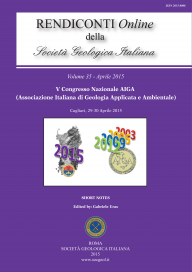
Terrestrial Laser Scanning survey of the Sugano cliff (Orvieto, Italy) for slope stability analyses
Elisa Brizi (a,c), Alessandro Brunetti (a), Salvatore Martino (b), Claudio Margottini (d), Paolo Mazzanti (a,b) & Gabriele Scarascia Mugnozza (b)
(a) NHAZCA S.r.l., Spin-off Company of "Sapienza" University of Rome, Via Cori snc, 00177, Rome, Italy. elisa.brizi@nhazca.com
(b) Department of Earth Sciences , Sapienza University of Rome, Piazzale Aldo Moro, 5, 00185, Rome, Italy.
(c) Centre for Research (CERI), Sapienza University of Rome, Piazzale Aldo Moro, 5, 00185, Rome, Italy.
(d) ISPRA – "Istituto Superiore per la Protezione e la Ricerca Ambientale", Via Vitaliano Brancati, 48 – 00144, Rome, Italy.
DOI: https://doi.org/10.3301/ROL.2015.58
Volume: 35/2015
Pages: 38-41
Abstract
The Terrestrial Laser Scanner (TLS) survey of the Sugano (TR, Italy) cliff has been performed with the aim of assessing by a remote position the main rock mass jointing features (such as dip/dip direction, spacing, opening, persistency etc). Geostructural analysis has been performed on the high resolution 3D point clouds collected in the frame of a two days survey by combining six survey positions. The results from the remote investigation of the cliff allowed to identify the limit equilibrium conditions for all the studied cases and provide geometrical information (volume, surface etc.) of the blocks more susceptible to instability.
Specifically, the kinematic of rock mass blocks was proved compatible with toppling phenomena tests under two independent triggering conditions: (a) hydrostatic water pressure within the joints and (b) seismic action. Safety factor (SF) values were attributed to these blocks in every studied conditions.
Keywords
Get Full Text